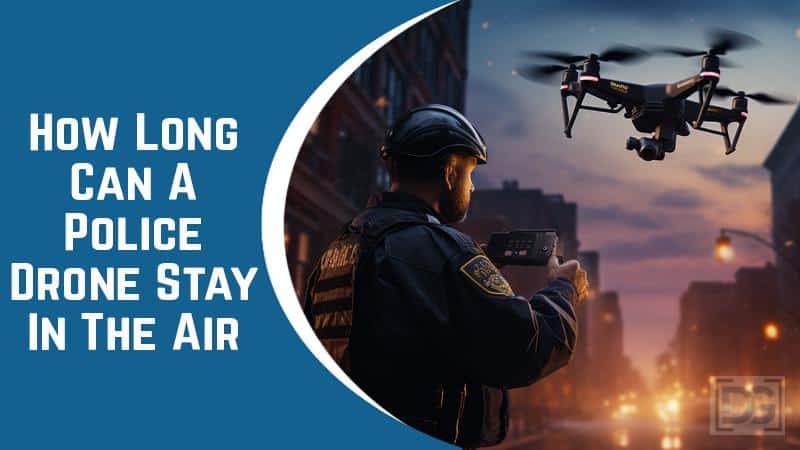How Long Can a Police Drone Stay in the Air. In recent years, drones have become invaluable tools for various industries, including law enforcement. Police departments worldwide increasingly turn to drones for surveillance, search and rescue missions, and crowd management. One of the critical factors that determine the effectiveness of police drones is their flight time. This comprehensive guide will explore how long a police drone can stay in the air, the factors affecting flight time, and much more.
Understanding Police Drones
Before delving into the specifics of flight time, it’s essential to have a basic understanding of police drones. These drones, also known as law enforcement drones, are specially designed uncrewed aerial vehicles (UAVs) used by police departments to enhance their operations. Police drones come in various shapes and sizes, but they all serve the common purpose of providing aerial surveillance and support. You may be interested in this also: What do drones sound like
Factors Affecting Drone Flight Time
Let’s get to the heart of the matter – what determines how long a police drone can stay in the air? Several crucial factors play a role in determining the flight time of a police drone:
- Battery Capacity: The primary factor affecting drone flight time is its battery capacity. Police drones typically use lithium-polymer (LiPo) or lithium-ion (Li-ion) batteries, which come in different capacities. Drones with larger batteries can stay in the air longer.
- Drone Weight: The drone’s weight impacts flight time. Heavier drones require more power to stay aloft, reducing their flight time compared to lighter models. When it comes to finding the perfect police drones then LEGO City Sky Police Drone will be a good option.
- Payload: Many police drones carry additional equipment, such as cameras, thermal imaging devices, or sirens. The weight of these payloads can significantly reduce flight time.
- Environmental Conditions: Weather conditions, including wind speed and temperature, can affect flight time. Drones may consume more power in adverse weather conditions, reducing flight duration.
- Flight Speed and Maneuvering: Flying at high speeds and making frequent maneuvers can drain the drone’s battery more quickly. Slower, more controlled flight extends flight time.
- Altitude: Flying at higher altitudes can improve flight time since the air is thinner, requiring less power to maintain size.
- Battery Health: Over time, a drone’s battery capacity may degrade, reducing its flight time. Regular maintenance and battery replacement are essential to maintain optimal flight duration.
Typical Flight Times for Police Drones
While the flight time of a police drone can vary significantly depending on the factors mentioned above, let’s look at some average flight times for different types of police drones:
- Mini Drones: Small, compact drones used for close-range surveillance typically have a flight time of around 15-20 minutes.
- Mid-sized Drones: Medium-sized police drones, often equipped with better cameras and longer battery life, can stay in the air for 30-45 minutes on average.
- Large Drones: Larger drones, such as those used for search and rescue missions, can have flight times ranging from 45 minutes to 2 hours or more.
It’s important to note that these are general estimates, and actual flight times can vary based on specific drone models and configurations.
Increasing Police Drone Flight Time
Police departments are constantly looking for ways to extend the flight time of their drones to maximize their effectiveness. Here are some strategies to increase police drone flight time:
- Use High-Capacity Batteries: Upgrading higher-capacity batteries can significantly extend flight time. However, this may require modifying the drone’s battery compartment to accommodate larger batteries.
- Optimize Payload: Evaluate the necessity of all equipment carried by the drone and reduce unnecessary payload weight to increase flight time.
- Battery Management: Implement proper battery management practices, such as charging and storing batteries at the right temperature, to maintain battery health.
- Invest in Solar-Powered Drones: Some police departments are exploring solar-powered drones that can stay in the air for extended periods, especially in daylight.
- Battery Swapping: Some drones are designed with swappable batteries, allowing officers to quickly replace discharged batteries with fully charged ones.
FAQs
Can police drones fly at night?
Many police drones are equipped with night-vision technology, allowing them to operate in low-light or nighttime conditions.
What is the maximum altitude a police drone can reach
The total length of a police drone is typically regulated by local aviation authorities. In the United States, for example, the FAA sets a total of 400 feet above ground level for drones.
Are there any legal restrictions on police drone flight time?
Legal restrictions on police drone flight time vary by jurisdiction. In general, police departments must adhere to the same drone regulations as civilian operators.
Conclusion
In conclusion, the flight time of a police drone depends on several factors, including battery capacity, drone weight, Payload, and environmental conditions. While mini drones may stay in the air for 15-20 minutes, larger drones can have flight times of up to 2 hours or more. To optimize flight time, police departments can upgrade to high-capacity batteries, reduce unnecessary payload weight, plan efficient flights, and implement proper battery management practices. As technology advances, we can expect even longer flight times for police drones, further enhancing their capabilities in law enforcement operations.

